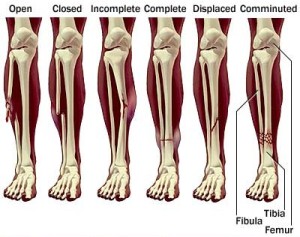A closed fracture is a broken bone that does not penetrate the skin 
Causes of Closed Fractures
As is the case with all fractures, closed fractures usually occur as a result of direct blow by high-energy trauma of an outside force on the bone. When this force is stronger than the bones, it results to a closed fracture. Some of the cases where force is greater than the bones are the following:
- Motor vehicular collisions or accident
- Sports injuries
- Falls
- Sometimes, certain conditions and disorders of the body weaken the bones in the body, increasing risks for closed fracture, such as:
- Osteoporosis
- Cancer
- Indirect force
- Abnormal muscular contraction
Signs and Symptoms of Closed Fractures
Because a closed fracture may not be as evident as open fractures, some may find it more difficult to tell if the bone is broken or dislocated. Dislocations usually occur in the joints. The following are signs and symptoms of closed fractures
- A breaking or cracking sound heard or felt
- Severe pain, especially in attempting to move, at or near the site the injury
- Difficulty moving or impossible normal movement
- Loss of power/ normal function
- Bruising and swelling on and/ or around the site of the injury
- Deformity in the bone or abnormal twist of limb
- Upon applying pressure, tenderness at or near the site of the fracture
- Paresthesia
How to Administer First Aid for Closed Fractures
Although it is not as serious as open fractures, closed fractures should still be given first aid nonetheless. First aid for close fractures will depend on the location and severity of the closed, fracture. However, the following hints are generally advised in cases of closed fractures:
- Assess the fracture.
- Immobilize the injured area. Do not attempt to push back the bone that’s visibly sticking out or misplaced. If one is trained to apply splint, apply a splint above and below the fractured area. Pads may be added to add comfort.
- Apply ice packs on the injured area to limit swelling and reduce pain. Ice should not be applied directly to the skin. Wrap the ice in towel or cloth.
- Elevate the fractured area to limit swelling.
- Remove any tight clothing and jewelries to avoid impeding circulation.
- Check and monitor for symptoms of shock. If shock symptoms begin to show, treat for shock.
- If necessary, initiate CPR.
Though it is the least dangerous type of fracture, first aid should still be administered to give comfort to the victim. To learn how to treat closed fractures and other bone-related injuries, join workplace approved First Aid Courses for hands on training.
